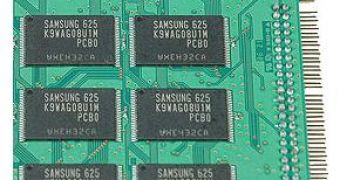A 32 GB Flash Drive from Samsung was tested by Tomshardware and the results are showing that in a few years, we may attend to the funeral of classic HHDs.
Integrated by an UltraATA/66 interface, it has limited thoroughput in the tests to a maximum of 50 MB/s. The drive weighs 46 g, with the PCB/chips weighing 29 g (the plastic drive casing comprising one third of total weight). Regular 2.5" drives clock in about 100 g total. There are 16x 16 Gbit Flash memory chips, giving the 32 GB total.
The power consumption when the unit is idle is next to nothing, drawing only 0.03 W. While in operation, the power consumption is 0.9 W. No noise is generated due to the lack of moving parts and rotation, and such a unit is not affected by shock in any way. Its footprint is smaller than of a regular 2.5" drive, although Samsung will offer larger sizes to allow for easy integration within existing form factors. Lastly, the unit does not get hot at all and can be operated in virtually any environment.
Samsung has released mobile computers based upon its Solid State Flash hard drives into the Korean market as of early June. The Q1 portable runs totally silent and boots Windows XP 25-50% faster than systems featuring traditional hard drives. Considering that the system runs on conventional Pentium M / Centrino hardware, the respective MSRPs of $2430 seems a little pricey.
Flash memory as an optional cache allows the user to take advantage of Vista's "ReadyBoost" feature, allowing for a peppier PC. Adding Flash memory to a hard drive makes for a hybrid hard drive, which allows Vista to intelligently prioritize data according to frequently used applications and client schedule to cut down waiting times even further. The ideal solution is, however, a hard drive that is entirely based on an array of high performance Flash memory. The downside is that Flash memory is expensive, running at about $25/GB. Fortunately, Flash-based drives should continue to become more affordable as time goes on.

 14 DAY TRIAL //
14 DAY TRIAL //